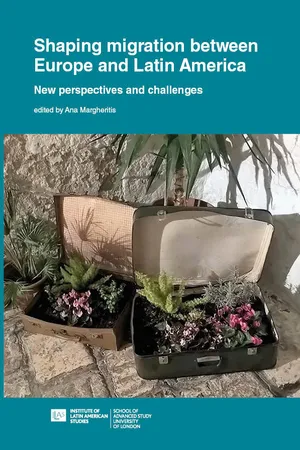
Shaping Migration between Europe and Latin America: New Perspectives and Challenges
- English
- ePUB (mobile friendly)
- Available on iOS & Android
Shaping Migration between Europe and Latin America: New Perspectives and Challenges
About this book
With its focus on Latin America and Europe, two world regions historically linked by human mobility and cultural exchange, this insightful interdisciplinary examination of their changing international migration patterns demonstrates how they are now responding to significant demographic changes and new migration trends.
The volume examines strategies pursued by state and non-state actors to address the political and policy implications of mobility, and asks to what extent is cross-regional migration effectively managed today, and how it could be improved. Its chapters provide an integrated and comparative view of the links between the two regions and highlight the formal and informal interstices through which migration journeys are negotiated and shaped.
Frequently asked questions
- Essential is ideal for learners and professionals who enjoy exploring a wide range of subjects. Access the Essential Library with 800,000+ trusted titles and best-sellers across business, personal growth, and the humanities. Includes unlimited reading time and Standard Read Aloud voice.
- Complete: Perfect for advanced learners and researchers needing full, unrestricted access. Unlock 1.4M+ books across hundreds of subjects, including academic and specialized titles. The Complete Plan also includes advanced features like Premium Read Aloud and Research Assistant.
Please note we cannot support devices running on iOS 13 and Android 7 or earlier. Learn more about using the app.
Information
Table of contents
- Cover
- Title Page
- Copyright
- Contents
- Acknowledgements
- Abbreviations
- Notes on contributors
- Mark Thurner
- Part 1. Framing the debate
- Part 2. Homemaking, ideas and institutions in a transatlantic journey
- Part 3. Agent-structure dynamics in contemporary migration flows
- Part 4. Conclusions
- Index